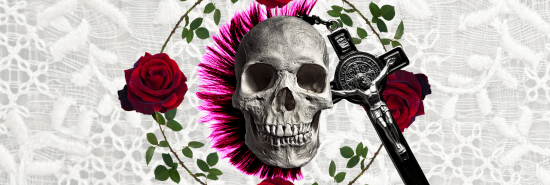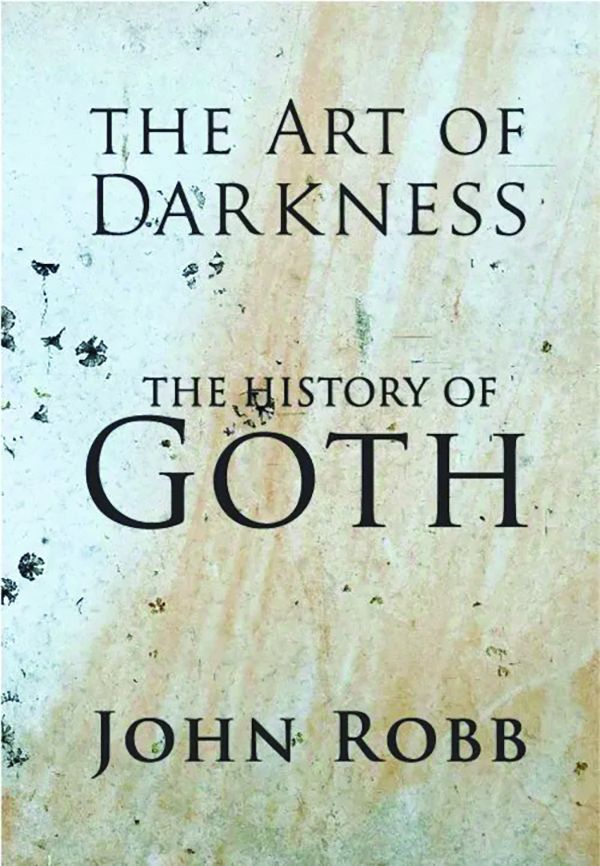
How romance, religion, and punk created Goth
Emma Collins
Some time ago, when I was a Gothic maiden living in a railroad apartment with a roommate and a small colony of cockroaches, we used to sit around the kitchen table smoking Djarum Blacks and seeing who could come up with the most repulsive band name. Punk rock devotees, we were certainly on the scene if not quite scene queens. At the time, my Instagram handle was @graveyardgrrrl, followed by a collection of numbers I can no longer remember. I had a crush on a boy known to the community as “Dirty Matt.” And every Wednesday, with religious devotion, I filed into a club called Home Sweet Home at about 11 p.m. to gather with other Goths.

Somehow, the band names we came up with were never quite as grotesque as the groups profiled by John Robb in his encyclopedic new The Art of Darkness: The History of Goth. Across 550 feverishly detailed pages, musician and journalist Robb describes obscure collectives with such monikers as Masters of the Backside, Controlled Bleeding, Alien Sex Fiend, and Fatal Microbes, as well as immortal bands such as the Cure, Bauhaus, and Joy Division. His book is unusual among compendiums of Goth music history in that it profoundly explores Goth’s cultural origins: the invasion of Rome by Germanic Visigoths, vaulted late-medieval cathedrals, and aesthetic movements such as the Romantics and the Decadents. Goth ultimately emerged from the ashes of punk in late 1970s Britain. And although the genre name was furiously rejected by many of its icons, it came to describe that specific strain of post-punk that signified an erotic alternative, according to Robb — a music that could credibly address themes of divinity, grief, life, and death.
One of the most pleasurable things about Robb’s tome is that it is not an academic text full of stuffy analysis. It’s more akin to sitting with a Goth elder in his lair full of memorabilia as he sips absinthe out of a skull-shaped mug and regales you with morally ambiguous tales from his youth. Picture this: As the evening begins, he starts to tell you about the early days of Goth clubs — how discontented youth with “defiant hair” and pointy-toed boots convened in rooms full of dry ice and drank a concoction called snakebite (a blend of lager and cider with a hint of blackcurrant). As the night wears on and your senses are loosened by the flickering fire, this venerable veteran of the underworld reveals to you the antecedents of your favorite song by My Chemical Romance or Nine Inch Nails. The Gothic sound has just as much to do with the nature mysticism of Wordsworth and the Symbolist poetry of Verlaine as it does with black eyeliner. Robb may be the only author capable of elucidating the connection between the Gnosticism of William Blake and teenagers buying spiked collars at Hot Topic. More than anything else, he is able to describe the essence of Goth as a “high Romantic sensibility which combines sensuality and religious faith.”
You’ll learn plenty about key singers and bands in The Art of Darkness, from the family background of Susan Ballion (aka Siouxsie from Siouxsie and the Banshees) to the history of legendary label 4AD. But you’ll also learn that Lord Byron was a debt-ridden, bisexual vegetarian (great combo) and that some of Baudelaire’s love verses carry “alarming necrophile overtones” (Note to reader: It’s best to leave this kind of thing off your Hinge profile). You’ll learn about how Lucifer got canceled in Milton’s Paradise Lost. Robb illustrates how the early punks tried to distinguish themselves from ordinary society — how they thought of themselves as “dissenters and thinkers” rather than “bankers and wankers.” He gives a sense of what it feels like to be in the Gothic community: “We could be our scary selves without horrifying each other.” In “the broad church of goth,” Robb says, there was belonging. He cites singer Ian Astbury as saying, “Class wasn’t important. Race wasn’t important. Gender wasn’t important.” It’s a punk-rock version of “You are all one in Christ Jesus” (Galatians 3:28).
If anything grates about this weighty account, it’s the sheer level of brain-numbing detail. Do I really need to know whether Iggy Pop impaled himself onstage in 1973 with a broken bottle as opposed to the shard of a drumstick? (OK, maybe.) The tiny and copious footnotes at the bottom of the page sometimes force a break in the rhythm of one’s reading, and it can be dizzying to take in the number of bands that are now consigned to the annals of Gothic apocrypha. But it is good that a rendering of this history exists somewhere, and perhaps the book is best kept as a source for consultation rather than a tale to be consumed in one go.
One of the most interesting things The Art of Darkness brings to light is the tendency of Gothic art and music to arise from rural settings. Describing the clubs that cropped up in the early days of Goth as being located in a “broken heartland” of “post-industrial … satellite towns, mill towns, [and] dead towns,” Robb distinguishes the ethereality of Gothic Britain — “the green and ghostly land” — from the urban flavor of punk predecessors. An aesthetic movement that originated in such undead places, inheriting the spirit of the Brontes’ “windswept moors,” was often brought to life by youngsters on “the dole queue” who thought they had no future. It was an era of economic struggle, and much of the new music was made by working-class children with nothing to lose. Drummer Rat Scabies explains, “There was other people with the same attitude and you were not the only one who was angry about what was going on, who couldn’t get a job and not have any money.” Perhaps there is an aesthetic vanguard ready to emerge from the American Heartland as well.
John Robb’s book is blessedly free of partisan proselytizing. While he acknowledges that there are Goths of many ideological persuasions, he notes that there has often been a strong current of apoliticism in the subculture. This is a welcome relief. Goth is more about the beyond than the here-and-now. Goth concerns itself with the elegiac, the unsettling, and the tomb. In fact, many people involved in Gothic life come from devout upbringings. “I was actually incredibly religious as a child,” one musician explains. The legendary Peter Murphy of Bauhaus disdained the g-word, thinking of his band as “holy” instead. The essence of Goth is perhaps best elucidated by one early participant: “It involves mysticism.” In music, faith, and life, there is a need for something beyond the light-filled and salvific. We need mystery as well. We need the supernatural, and there will always be those of us who summon it.
CLICK HERE TO READ MORE FROM THE WASHINGTON EXAMINER
Emma Collins is a writer based in Washington, D.C. You can find her newsletter, A New Heaven, on Substack.
